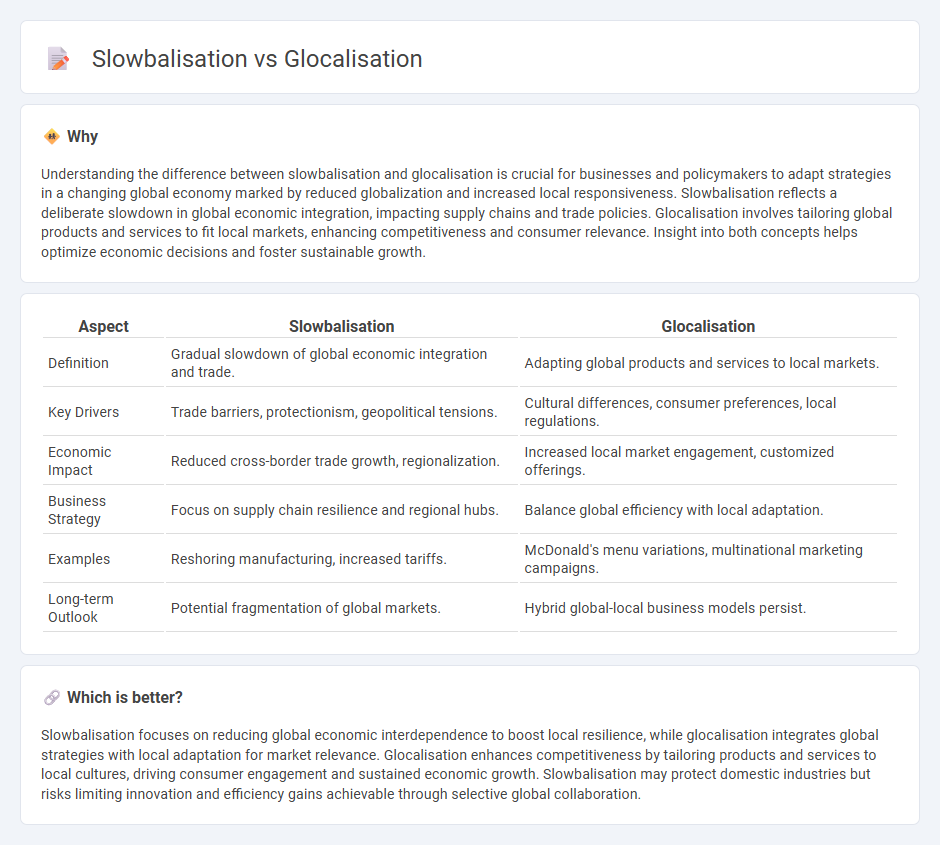
Slowbalisation describes the deceleration of globalization processes due to rising protectionism and regional trade barriers, impacting international supply chains and economic growth. Glocalisation emphasizes adapting global business strategies to local markets, blending global efficiencies with local cultural preferences to enhance competitiveness. Explore how these trends are reshaping global economic landscapes and corporate strategies.
Why it is important
Understanding the difference between slowbalisation and glocalisation is crucial for businesses and policymakers to adapt strategies in a changing global economy marked by reduced globalization and increased local responsiveness. Slowbalisation reflects a deliberate slowdown in global economic integration, impacting supply chains and trade policies. Glocalisation involves tailoring global products and services to fit local markets, enhancing competitiveness and consumer relevance. Insight into both concepts helps optimize economic decisions and foster sustainable growth.
Comparison Table
| Aspect | Slowbalisation | Glocalisation |
|---|---|---|
| Definition | Gradual slowdown of global economic integration and trade. | Adapting global products and services to local markets. |
| Key Drivers | Trade barriers, protectionism, geopolitical tensions. | Cultural differences, consumer preferences, local regulations. |
| Economic Impact | Reduced cross-border trade growth, regionalization. | Increased local market engagement, customized offerings. |
| Business Strategy | Focus on supply chain resilience and regional hubs. | Balance global efficiency with local adaptation. |
| Examples | Reshoring manufacturing, increased tariffs. | McDonald's menu variations, multinational marketing campaigns. |
| Long-term Outlook | Potential fragmentation of global markets. | Hybrid global-local business models persist. |
Which is better?
Slowbalisation focuses on reducing global economic interdependence to boost local resilience, while glocalisation integrates global strategies with local adaptation for market relevance. Glocalisation enhances competitiveness by tailoring products and services to local cultures, driving consumer engagement and sustained economic growth. Slowbalisation may protect domestic industries but risks limiting innovation and efficiency gains achievable through selective global collaboration.
Connection
Slowbalisation reflects a deceleration in global economic integration driven by rising trade barriers and geopolitical tensions, prompting businesses to adopt glocalisation strategies that blend global efficiencies with local market adaptation. Glocalisation enables companies to customize products and services to regional preferences while maintaining competitive advantages in a fragmented global economy shaped by slowbalisation trends. This interconnected dynamic fosters resilient supply chains and diversified market access, balancing global reach with local responsiveness.
Key Terms
Supply Chains
Glocalisation in supply chains emphasizes localization by adapting global supply chain strategies to meet regional market demands and regulations, enhancing flexibility and reducing risks from geopolitical disruptions. Slowbalisation reflects a deceleration in global supply chain integration due to rising trade barriers and reshoring trends, which prioritize resilience and sustainability over cost efficiency. Explore deeper insights on how these trends reshape the future of supply chain management.
Cultural Adaptation
Glocalisation emphasizes cultural adaptation by tailoring products and marketing strategies to meet local customs, languages, and preferences, enhancing relevance and customer engagement. Slowbalisation promotes a more mindful, regionally-conscious approach to globalization, encouraging deeper cultural understanding and sustainable local partnerships. Explore how these strategies reshape global business dynamics and cultural integration.
Trade Flows
Glocalisation emphasizes adapting global trade strategies to local markets, enhancing regional supply chains and consumer relevance, while slowbalisation reflects the gradual slowdown and reconfiguration of global trade flows due to geopolitical tensions and reshoring trends. Trade volumes show a shift from rapid globalization peaks to more stable, localized exchanges, impacting multinational corporations and trade policies worldwide. Discover more about how these contrasting trends reshape international commerce dynamics.
Source and External Links
Glocalization Vs Globalization - What are the Differences? - Glocalization is the adaptation of global products and strategies to local markets and cultures, allowing multinational companies to customize offerings based on local laws, behavior, and preferences to increase trust and market share regionally.
What is Glocalization? (Definition & Meaning) - Lingoport - Glocalization combines globalization and localization by customizing global products or services to fit local cultures, languages, and regulations while maintaining a global brand identity, helping companies balance global strategy with local relevance.
Glocalization | Understanding Global & Local Markets - Britannica - Glocalization involves creating global products or services adapted to local cultures, resulting in cultural and economic hybridization, and represents a dynamic interaction where both local and global influences shape identity and market strategies.
 dowidth.com
dowidth.com